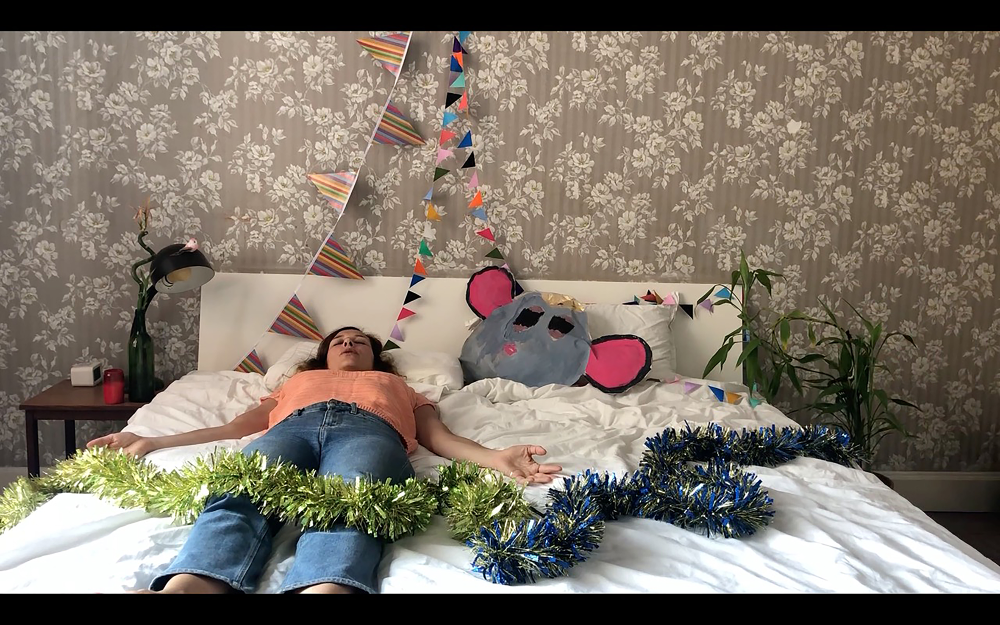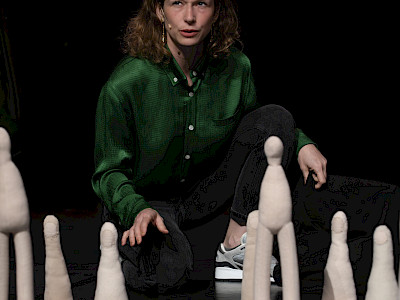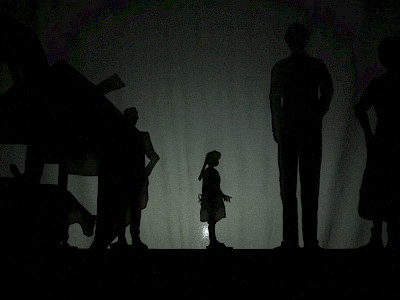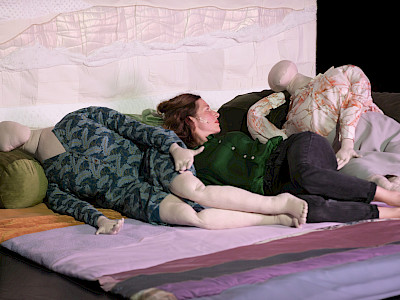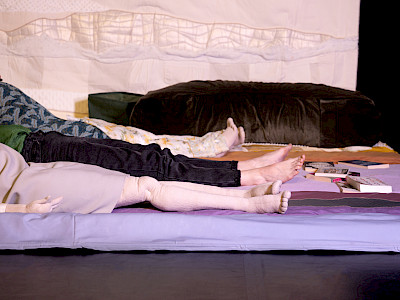12 — 14.05, 16.05.2023
Sarah Vanhee Brussels
Mémé
theatre — premiere
| West Flemish, Dutch, English → FR, NL, EN | ⧖ ±1h30 | €18 / €15
How does the world of today correlate with the forgotten women of the past, and to the land these women worked? And how do we see those women reflected in the forgotten women of today, whose labour continues to be exploited? Mémé is a layered, intergenerational, multilingual performance about our relationship to our ancestors, the (native) soil, and the female body. This is Sarah Vanhee’s ritualistic attempt to bring her West-Flemish grandmothers back to life. Like other women of their time, they spent most of their lives in ‘labour’: birthing and raising children and working in the home and in the fields, always in service of others. Alone on a stage populated with voices, Vanhee is surrounded by puppets, ghosts, shadows, and children – created in collaboration with puppet-maker Toztli Abril de Dios and sound artist Ibelisse Guardia Ferragutti. Partly in the West Flemish dialect, Vanhee commemorates our matriarchal affiliations, seeks to reconnect with her grandmothers, and finally says goodbye. Mémé is an ode to all invisible women, the earth, life itself, work and pleasure.
Mémé
A conversation with Sarah Vanhee
Myriam Stéphanie Perraton Lambert – Mémé is a tribute to your deceased grandmothers. By delving into your family history in West Flanders, you highlight maternal labour and filial ties, but above all, our ways of being together and our ways of telling and writing our stories. Tell us a little about this encounter with your ancestors and how it is embodied on stage.
Sarah Vanhee – Mémé is a celebration of our lives being intimately connected to the land from which we come. I come from a family where a sense of work and duty is central; even the name of my maternal grandmother’s village, Werken, means ‘work’. For most of their lives, my grandmothers’ bodies were at the service of the household and its maintenance: tilling the land, caring for the house and the family, repeatedly giving birth. Their bodies were functional and utilitarian, serving the mores of the time. Their body served very little as a channel for pleasure, sensuality, joy and fulfilment. The same applies to the soil of our native land. It is a farming region that was ravaged by trench warfare. Although my grandmothers worked and walked on this land every day of their lives, I don’t think they really had the chance to encounter nature in any other way than the functional. On stage, I invite them to a pillow talk, a space conducive to daydreaming, complicity, and the invention of stories. I invite them into this benevolent and feminist environment in order to share with them a part of the care and joy I’ve learned to offer myself. In doing so, I wish to lend another meaning to the maternal role that they’ve each had to integrate in their own way within the contingencies of their time. For example, the videos I made with my son show how the times (the era, the climate, the customs, the rhythm…) allowed my relationship with him to be very different from that which my grandmothers experienced with their children.
An important part of your artistic work is the aspect of infiltration and intervention in non-theatrical public places. As with Oblivion (2015) and Unforetold (2018), this time you are returning to the black box. Why does Mémé need the theatre?
In collaboration with puppeteer and object designer Toztli Abril de Dios, sound designer Ibelisse Guardia Ferragutti, and choreographer Christine De Smedt, we literally explore the idea of playing at the theatre; of playing at making theatre. The performance is entirely manual and everything from the machinery is visible. It’s a play that is entirely handmade by women. Toztli, Ibelisse, Christine and I share a multidisciplinary approach and a predisposition for craft and physical skills. As the artisans of this show, we did not only work on our ‘own’ elements, but each of us was involved with the entire piece. Between our hands and the working of the material; our knowledge, our experiences, our strengths and our stories are woven into this piece made of objects, sounds, movements and texts. Each seam between these different languages reveals a caring, an encounter, and a memory. The stage is thus inhabited by many presences, and although it’s a solo piece, I do not feel alone. Of course, the black box is also conducive to ritual, to evocation, and to the imaginary.
The question of caring forms a knot with coercion (social, physical, reproductive, economic) that is never easy to undo. How does the piece bear witness to this polarity with which maternal labour is charged?
“Caring caring caring… that’s all her life was about,” my mother would say about my grandmother. “Mémé”, her mother, was a strong and generous woman for whom a sense of community and sharing was very important. As for my father’s mother, she was depressed all her life. She didn’t have the mental strength to meet the expectations of her time. They each took on the maternal role that was imposed on them, with very different capacities and agency. One came out of it strong and the other, rather damaged. These are two unique and complex stories, but in a sense they’re universal.
In one of her writings, the Belgian philosopher Vinciane Despret states that once recalled to life or memory, “ghosts are not good in explanatory schemes, they just have to be there. They must be honoured, but they cannot explain anything […] they must rather complicate things.” 1 What do you think?
That quote is very evocative of this piece. This journey that brings my ancestors back to life complicates and complexifies certain questions for which I have not yet found answers. Invoking ghosts allows us to name absence and oblivion, to put into words and into presence what we do not understand and what has not been said. With Mémé, I seek to understand what this transgenerational suffering consists of, but above all, to celebrate our intertwined lives and to imagine our meeting in the midst of an intimacy that we never had the chance to share during their lifetime. My Oma’s and my Mémé’s dolls do not speak. They have no text. The time we’re meeting in is one of fiction; it’s a time of evocation, of possibilities, of play, of discovery. So there is no dialogue. It’s only me speaking through them, and them speaking through me. Part of the piece also concerns the history of my family’s silences, which I have collected and archived. These silences are also those of the landscape of my childhood in Flanders. It’s a flat landscape with very little relief. The horizon of this landscape always seems to me to be traversed by a silence full of wandering ghosts.
In the family environment, children are sometimes involuntarily forced to submit to the family game by assuming a predestined role. This is why it’s sometimes so difficult to meet oneself, to discover oneself as a singular and different being. Mémé seems to open up a breach in this area: a conversation between the ‘we’ of the family and the ‘self’ of a child. What place does this space of (re)construction occupy in your work?
Art is, for me, the third element that allows us to transcend this everyday life and the roles we play in it. What I call the “third element” in my work is the mediating object between the two sides of a conversation. Something that transcends the banality of life, opens up perspectives, allows for the right distance and a new consciousness in dialogue. It is the artwork in Untitled (2012); it is the manu-script in my work with Claire C (The C-Project, 2010); it is the script of a crime film I composed with inmates in the documentary The Making of Justice (2017). I think Mémé is that third element in my relationship with my family. It’s funny, sometimes I don’t know who I am in this piece any-more. The daughter, the mother, the grandmother, or a mes-senger. I play a plurality of female roles and I believe that this play-space is a space of transformation, of reinvention of the self. It would be very restorative if there was more room for ritual in families again. We all need spaces to symbolise, to embody and give shape to our experi-ences in order to better reinvent ourselves.
Interview by Myriam Stéphanie Perraton Lambert
April 2023
Myriam Stéphanie Perraton Lambert is a dramaturge. Her research focuses on choreographic, visual, and textual writing for women. She is a lecturer at the École supérieure de théâtre – l’UQAM and teaches dramaturgy at the École de théâtre professionnel at Collège Lionel-Groulx.
1 Vinciane Despret, “La tentation de l’innocence : conver-sation avec Donna Haraway et Isabelle Stengers”, in Habiter le trouble, p.333-334, Éditions du dehors, 2019.
Presentation: Kunstenfestivaldesarts, De Kriekelaar
Concept, text and performance: Sarah Vanhee | Objects and scenography: Toztli Abril de Dios | Sound: Ibelisse Guardia Ferragutti | Outside eye: Christine De Smedt | Technicians: Babette Poncelet, Geeraard Respeel | Performance on screen: Leander Polzer Vanhee | With the valuable input from: the Vanhee-Deseure family | Dedicated to: Margaretha Ghyselen & Denise Desaever | English translation: Patrick Lennon | French translation: Isabelle Grynberg | Dutch translation and surtitels: Marika Ingels
Production: CAMPO | Coproduction: Kunstenfestivaldesarts, Kaaitheater, Wiener Festwochen, BUDA, HAU Hebbel am Ufer, De Grote Post, Théâtre de la Bastille, Festival d’Automne à Paris and Perpodium
With the support of: taxshelter of the Belgian Federal Government via uFund
Residencies: KWP Kunstenwerkplaats, Kaaitheater, BUDA
Acknowledgements: Leontien Allemeersch, Katia Castañeda, Wout Clarysse, Gabriela de Dios, Elena Gore, Claudine Grinwis, Flore Herman, Alfredo Méndez, Leonie Persyn, Manuel Reyes, Jochem van Tol
